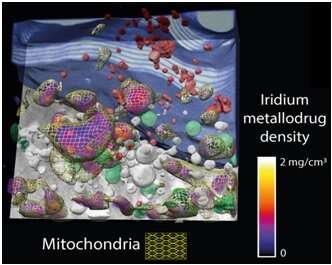Nanoimaging the intracellular space to aid drug development

Chemotherapeutics are key players in the clinical setting to fight most types of cancer, and novel chemicals could facilitate new and unique intracellular interactions that modulate the cell machinery and destroy the tumor cells. Equally necessary are new tools to locate and quantify such molecules in the intracellular nano-space so that their therapeutic action is fully understood.
Pizarro's research team at IMDEA Nanociencia has developed a new family of organo-iridium drug candidates about 100 times more potent than the clinically used drug cisplatin. Importantly, in collaboration with researchers at the ALBA and ESRF synchrotrons, and at the National Centre for Biotechnology, they have discovered that the mechanism of therapeutic action of this family of iridium-based anticancer agents appears to be radically different from that of cisplatins, a finding crucial to circumventing drug resistance.
Dr. Ana Pizarro explains: "Using highly advanced synchrotron cryo-techniques, we have been able to observe our extremely potent iridium drug candidate in cryopreserved breast cancer cells with nanoscale resolution. This means that we have been able to unambiguously locate iridium in the cancer cell mitochondria, and most strikingly, nowhere else." It is important that the drug has been exclusively located in the mitochondria, as this can minimize off-target interactions, which usually lead to the undesirable side effects that chemotherapy triggers in cancer patients.
Dr. Javier Conesa, key investigator in this project, says, "We have also been able to quantify the iridium drug specifically inside the mitochondria, which is also very important and unique, and not possible when tagging with fluorophores or with bulk experiments. Also, it is important that the detection was performed using whole cells, without any sectioning, which allows us to resolve the whole cell context in cryo conditions, which means that the cell structure and chemical composition is closely preserved to the native conditions. This newly developed 3-D correlative technology can also be applied to other biological problems, and hence we expect to study the distribution of other interesting elements."
Pizarro adds: "These compounds have the potential of being extremely effective against cancer, yet unless we fully understand their complete journey within the tumor cell, they don't stand a chance to enter the drug development pipeline. Not only will this understanding advance truly novel chemotherapeutics in the clinic, it will provide innovative tools to intervene processes related to cancer progression. It is a long road and this work represents the first step." The work has recently been published in the journal Angewandte Chemie International Edition.
More information: José Javier Conesa et al. Unambiguous Intracellular Localization and Quantification of a Potent Iridium Anticancer Compound by Correlative 3D Cryo X‐Ray Imaging, Angewandte Chemie International Edition (2019). DOI: 10.1002/anie.201911510
Journal information: Angewandte Chemie International Edition
Provided by IMDEA Nanociencia





















